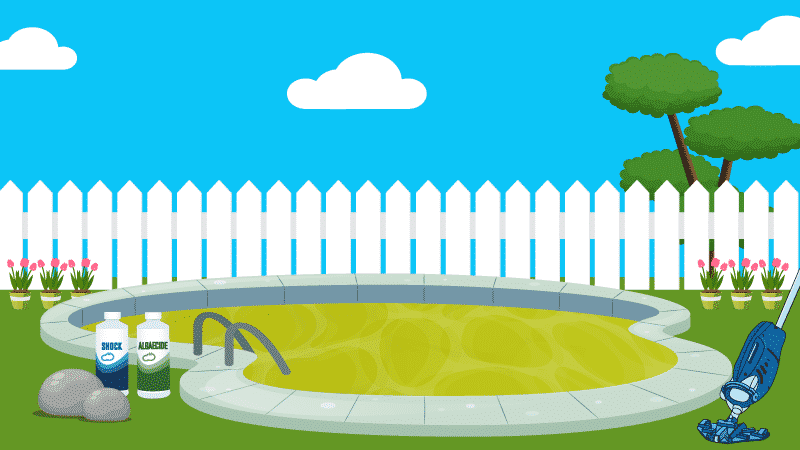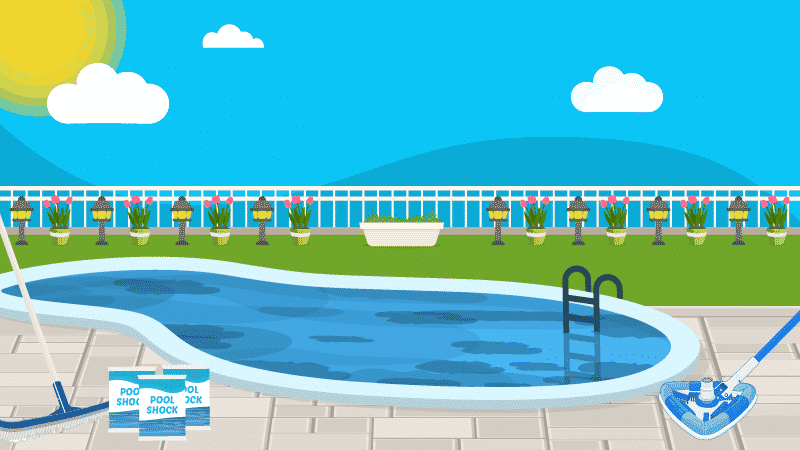How to Get Rid of Pool Foam
You expect to see lots of bubbles coming out of the return jets in your pool. They actually look pretty, sparkling in the sunlight as they burst on the surface of the water.
But when all those bubbles stay on the water, don’t pop, and start to accumulate to the point where the surface is covered with them, you have a problem: pool foam. Don’t worry, though. It’s fairly easy to get rid of, and even easier to prevent.
Stop wasting time and money with confusing water chemistry and maintenance. Our effortless system guarantees to keep your pool balanced, sanitized, and crystal clear all year. Works for all pools including saltwater.
What is Pool Foam?
At first glance, it may just seem like air bubbles in your pool. But pool foam is made up of more than just air.
Finding foam in your pool usually means there’s a high organic load in the water. In other words, more organic material than can be dissolved in the water, or eradicated by sanitizer. This causes the water to “thicken.”
Whereas air bubbles are light and don’t have a lot of surface tension, they easily pop at the lightest application of force. With pool foam, it’s sort of the opposite.
As the pool water is agitated by the return jets—or even just a breeze on the water’s surface—bubbles are created. They’re filled with air, but the surface of those bubbles is made up of that organic material buildup, so they’re not as easy to pop. Instead, they remain on the surface and become foam.
How Can I Get Rid of Pool Foam?
It will depend on the cause. Chemical imbalances, high levels of organic contaminants, or a low calcium level can all create pool foam. In some cases, shocking the pool will solve it. In others, you may need to balance the water chemistry, or change the pool chemical brands you’re using.
What Causes Pool Foam?
No matter how vigilant you are about cleaning your pool and keeping the water balanced, you may still occasionally end up with pool foam. This is because it comes from innocuous sources, and sometimes, even from pool chemicals themselves.
Hair Care Products
You don’t have to have a ton of gel or hairspray in your hair to introduce organic contaminants into your pool. Even just the residue left behind by your shampoo and conditioner can eventually build up enough to become a pool foam problem.
How to Fix It: Shock your pool, preferably with chlorine shock. The superchlorination will eradicate the contaminants and help bring your pool water back to its normal, clear state. You can use chlorine-free shock if you prefer, but you may not get the best results.
How to Prevent It: Rinse off before you swim, and be sure to rinse your hair well both after shampooing and before getting into the pool. If you have a lot of product in your hair, like mousse, paste, or hairspray, actually washing it and then rinsing it well is even better.
A powerful oxidizing agent that eliminates combined non-sanitizing chlorine (chloramines) and provides higher free chlorine levels. Helps eliminate algae growth as well as harmful bacteria. Ideal for use with chlorine or bromine sanitized applications, weekly maintenance, and will not affect other chemical levels
Other Toiletries
Aside from your hair, think about all the other products you apply to your body every day. Deodorant, lotion, makeup, perfume or cologne will all leave organic contaminants behind in your pool water.
How to Fix It: Second verse, same as the first: Shock the pool.
How to Prevent It: Still the same old song: Shower before you get into the pool.
High Bather Load
All those toiletry products that you may leave behind in the water? Now multiply that by the number of people using your pool.
Then add other contaminants like sweat and urine. Even if no one actually pees in the pool, there’s still residue on bodies that aren’t freshly showered. And if there’s urine residue, there’s also … we’ll leave that one to your imagination.
How to Fix It: Shock the heck out of your pool.
How to Prevent It: Make it a rule that anyone who wants to use your pool must at least rinse off—but preferably shower—before they can put even one toe in the water.
Will this make you unpopular? Maybe. But it’s that or swimming in other people’s bodily fluids—it’s up to you.
This fast-acting, quick-dissolving swimming pool shock kills bacteria, controls algae, and destroys organic contaminants in pools.
Soap or Laundry Detergent
Yup, even the substance you use to wash yourself, and which is supposed to rinse off your skin, can leave residue behind. This is especially true of those soaps and shower gels that claim to moisturize your skin. They have to leave something behind in order to do that.
Same goes for laundry detergent. How do your clothes still smell fresh after they’ve been rinsed and dried? Because there’s detergent residue on them, not to mention the coating of tallow (that’s rendered animal fat) deposited on your clothing by fabric softener and dryer sheets.
You wear the clothes. The residue gets on your body. Your body gets in the pool. The residue gets in the pool.
How to Fix It: Shock it. A theme is emerging here.
How to Prevent It: You have a couple of options. Again, there’s showering before swimming.
But you can also consider changing or eliminating some of the products you use to wash your clothes. Look for fragrance-free laundry detergent. Also consider trying “green” detergent options that have fewer ingredients, and are environmentally friendlier.
Instead of fabric softener, try using white vinegar to soften your clothes, not to mention reduce static cling and keep the inside of your washing machine clean.
All-natural and diluted to a cleaning strength of 30% acidity.
Instead of dryer sheets, try wool dryer balls, which are said to also help your clothes natural pool cleaner rather than adding even more chemicals to the water. We get it.
The thing is, when you use those household products, you must make absolutely sure you’re using them correctly, and not allowing them to leave anything behind in the water. Otherwise, you know what happens, right? Pool foam.
How to Fix It: We’re going to let you guess the answer to this one. OK, fine, we’ll tell you. Shock the pool!
How to Prevent It: Be very careful when using products not specifically made to clean your pool. Or, just go ahead and use a pool cleaning product. You can try to find one that’s environmentally friendly.
Pool Chemical Issues
You could have a couple of things going on here. First, maybe the pool water isn’t balanced the way it should be. If things get too out of whack—especially with your sanitizer—you can end up with a case of pool foam.
Or maybe you were trying to save some money, and you bought the cheapest chemicals you could find. We don’t mean the least expensive options from the pool store. We’re talking the chemicals you can buy in bulk from big-box stores that don’t specialize in pool chemicals.
If those chemicals don’t meet the minimum standards for maintaining your pool, they can actually do more harm than good, and one way that will be apparent is when you end up with a foamy pool.
Tests for 7 important chemistries in seconds: Total Hardness, Total Chlorine, Total Bromine, Free Chlorine, pH, Total Alkalinity, and Cyanuric Acid.
How to Fix It: You’ll need to balance your pool water.
- Test the water using test strips or a liquid test kit.
- Balance the alkalinity first. It should be between 100 parts per million (ppm) and 150 ppm, with 125 ppm being ideal.
- Balance the pH level. It should be between 7.4 and 7.6, with 7.5 being ideal.
- Balance the calcium hardness level. It should be:
- between 175 ppm and 225 ppm for vinyl and fiberglass pools
- between 200 ppm and 275 ppm for concrete and plaster pools
- Balance the sanitizer level according to the recommendation for whatever sanitizer you use to maintain your pool chemistry.
Once the water is balanced, wait a few hours to see whether the pool foam dissipates. If it doesn’t, you’ll need to … you guessed it: Shock the pool.
How to Prevent It: Test your pool water frequently and keep it balanced.
Also, buy pool chemicals from reputable, recognized brands, or directly from a pool store or pool maintenance professional.
This complete water testing kit helps keep your pool or hot tub clean and safe to swim in, with easy-to-follow color instructions and all the supplies you need in one box.
Low Calcium Level
Speaking of keeping your pool water balanced, if you allow the calcium hardness level to drop too low, you can end up with a pool foam problem on your hands.
When the calcium level drops too low, the water becomes too soft, and that leads to foam production.
How to Fix It: Add a calcium hardness increaser, or simply add calcium chloride to your pool. Follow the manufacturer’s instructions to add the correct amount.
How to Prevent It: Keep your water balanced, and don’t allow the calcium level to drop below the lowest recommended level.
Adding calcium hardness to your pool water will protect and extend the life of your pool walls including vinyl, fiberglass, and concrete.
Algaecide
Wait, how can a chemical made specifically to take care of your pool cause a problem like pool foam?! That just doesn’t seem right.
Well, here’s the thing. Pool chemicals must be used correctly, in the correct amounts, and at the correct times. Use a pool chemical incorrectly, and … there you go. Algaecide falls into this category.
How to Fix It: This is an easy fix. All you have to do is wait, and it should dissipate on its own after a few days. While you’re waiting, you can also skim the foam from the surface of the water to speed up the process.
How to Prevent It: Pool startup kits often include algaecide. This is great if you uncover your pool to find you’ve had an algae bloom over the winter.
But if you add algaecide to your pool when there’s no algae for it to kill, it doesn’t have anything to do or anywhere to go. It will thicken the water, and the slightest agitation of the water will create pool foam.
This is true of using algaecide anytime there’s no algae present in the water. It shouldn’t be used as a preventive measure. To keep algae from blooming in the first place, make sure you keep the sanitizer level where it needs to be.
Also, if you use too much algaecide—even when there is algae in the pool—it can cause foaming, and then you have two problems to address.
You also want to look for polyquat 60 algaecide as it is much less likely to produce pool foam than other algaecide types.
A copper-free algaecide to help prevent your pool from turning green.
Finally, this is another chemical not to skimp on. Cheaper brands may be more likely to cause foaming in the pool. Stick with known brands you buy from reputable sources.
Fast Remedy for Pool Foam
So far, all the remedies require time. You can’t swim right after shocking the pool, and if you’re waiting for algaecide to dissipate, it may be days before you see a change.
What if you have a pool party planned, and you only have a few hours to get your pool in shape for guests? You have one final option: an anti-foam chemical, also called a defoamer.
Contains a water-based formula that won't mess up your water chemistry. And it doesn't leave an oily residue or cloud the pool water.
This will make the pool foam disappear right before your eyes, but you only want to use it in a pinch. Remember, it treats the symptom, not the cause. You’ll still need to address the underlying problem later.
There’s a time and place for foam, and it’s never in your pool. Beer? Yes. Bubble bath? Of course. Swimming pool? Absolutely not.
Keep up with your pool maintenance, keep the water balanced, and use the best chemicals you can buy in the proper amounts, and you should be able to avoid any pool foam mishaps.
Happy Swimming!
3 Ways We Can Help With Your Pool
- Pool Care Cheat Sheets (Free): Easy-to-use downloadable guides to help you keep track of taking care of your pool this year.
- The Pool Care Handbook: An illustrated guide to DIY pool care, including water chemistry, maintenance, troubleshooting, and more.
- The Pool Care Video Course: You’ll get 30+ step-by-step videos and a downloadable guide with everything you need to know about pool maintenance.

















